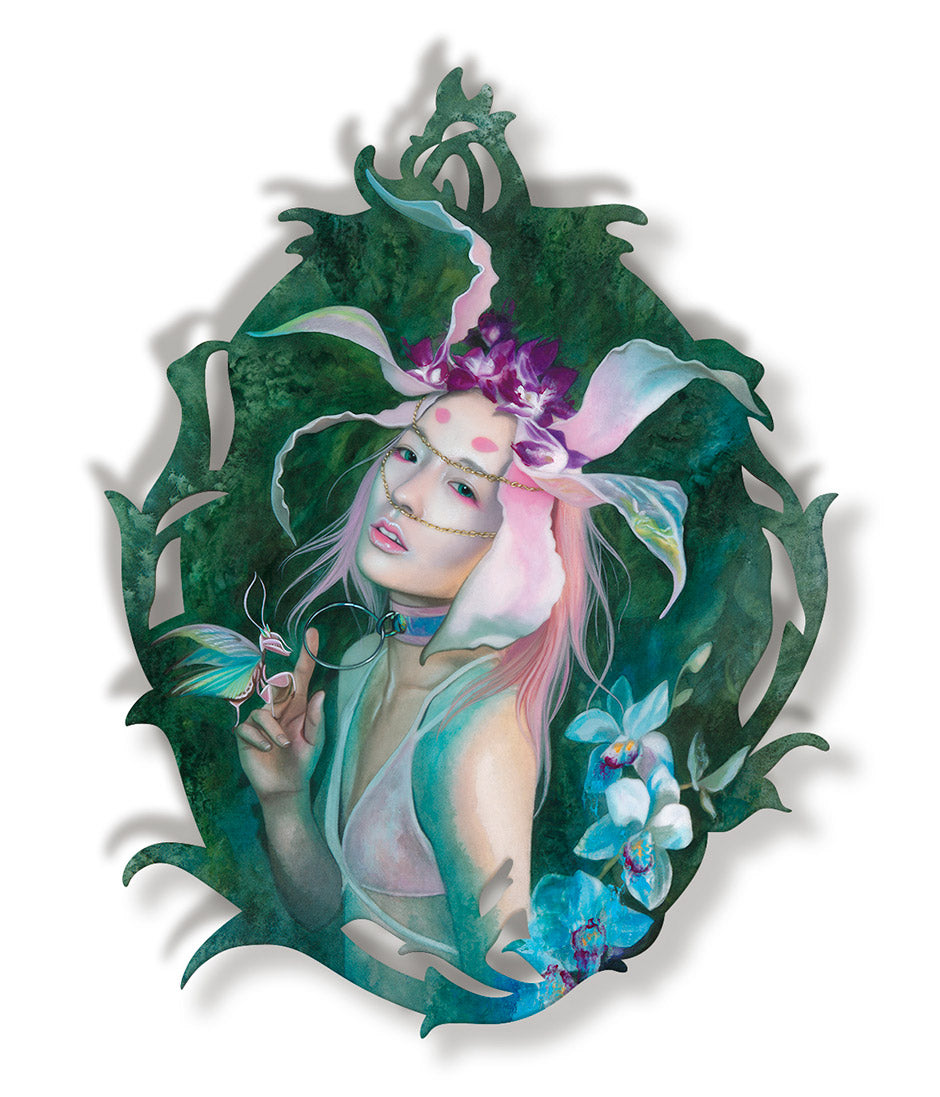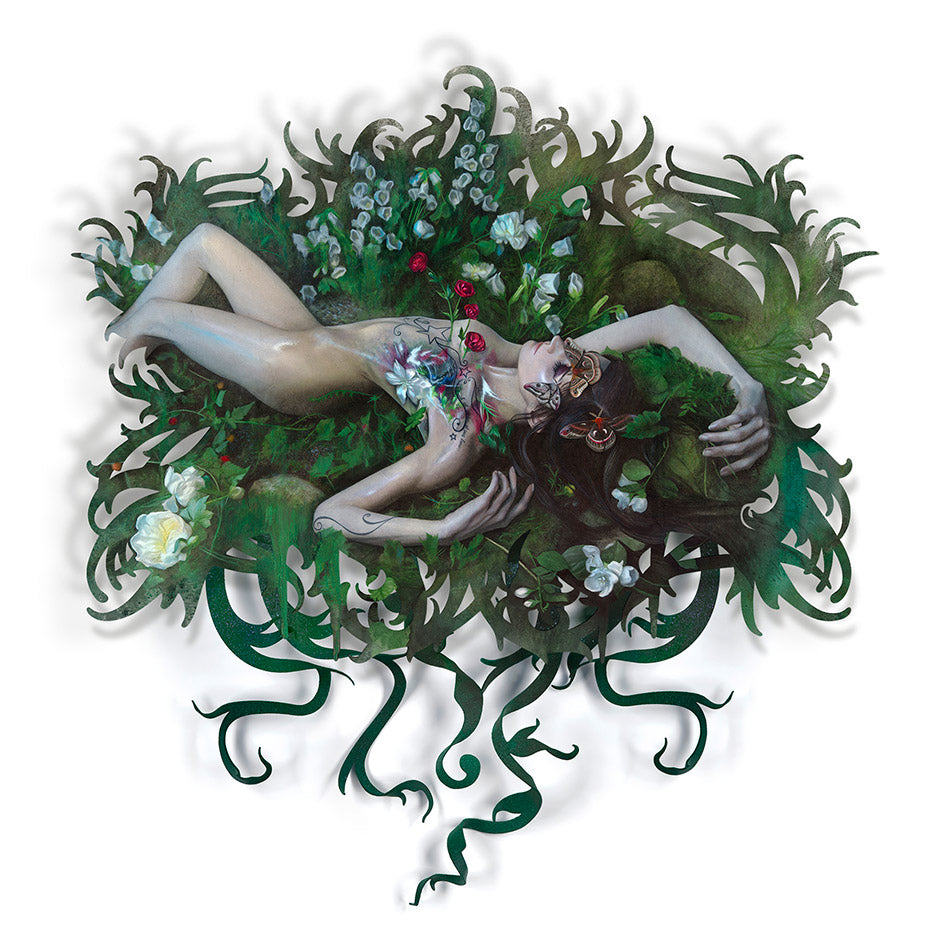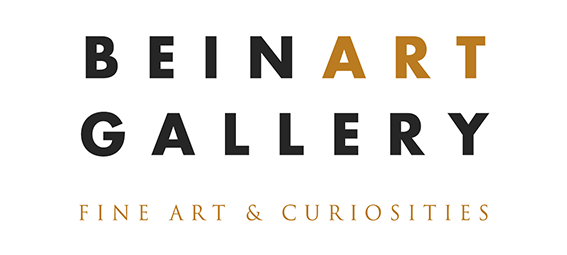 Left: "Annihilation" on the easel - Right: Redd Walitzki in her studio finishing works for Lush.
Left: "Annihilation" on the easel - Right: Redd Walitzki in her studio finishing works for Lush.
Suspend disbelief and escape into a botanically-infused dreamscape inhabited by enchanting, feminine sprites. Through an ornamental proscenium you enter a world bewitched with undertones of fantasy and magical overlays, the other-worldliness of it all masking the historical basis for the stories there told. This is the world of Seattle-based figurative-artist, Redd Walitzki.
Walitzki’s art is immediately identifiable upon entering the gallery or, as is the case these days, without even clicking to enlarge. Her pieces are self-framing, with delicately intricate and intricately delicate designs cut into the surface of each painting. The aesthetic is one reminiscent of antiquity yet executed with modern, laser technology. Each piece mysteriously appears to hover two inches from the wall, as if by magic, accentuating the fantastical ambience and casting an ornamental shadow on the wall behind, creating a sense of depth and dimension.
See available paintings by Redd Walitzki.

"Rite of Spring" - oil and mixed media on lasercut panel for Lush.
Legends of orchid hunters in the Victorian-era have been on Walitzki’s mind lately. Orchids were unknown to Europe until 1818 when the first specimens inadvertently arrived in London, having been used - according to popular myth - as packing-material in a consignment of tropical plants sent from Rio de Janeiro. This ultimately sparked an ‘orchid fever’ in London, with armadas of orchid hunters being despatched on dangerous sorties into tropical locations to retrieve commercial volumes of specimens. The dangers they faced seem almost unbelievable and defy contemporary parameters of occupational health and safety. In one 1901 expedition, eight orchid hunters ventured into the Phillipines, but only one returned alive. The others were either eaten by tiger, burnt alive or vanished altogether. Orchid hunters in Papua New Guinea were beheaded or had intimate body parts amputated in conflicts. Their counterparts in the Solomon Islands were tortured and killed by local cannibals.
These remarkable stories have inspired a new body of work which will feature in the Lush group exhibition at Beinart Gallery, opening on 18 November 2017.
Walitzki recently discussed this new body of work, her creative process and her other artistic endeavours with Luke Barrett.

"State of Decay" - oil and mixed media on lasercut panel for Lush.
“While in a way these figures have fallen victim to their plight, there is also the sense that they are a part of a natural cycle. There is power in that as well, and especially as our world alters due to human intervention, it’s important to continue to remind ourselves we are a part of these natural processes.” —Redd Walitzki
Luke Barrett: You recently created an image for Anomie Belle's Flux album, as part of a group exhibition for Modern Eden. I saw that painting of yours still being used in her concerts. Outside of galleries and private collections, are there any other unexpected places where we should keep an eye out for your work?
Redd Walitzki: It was a huge honour to collaborate with musician Anomie Belle for her recent album! My painting of her was the cover art for the US release; the CDs, iTunes and the special edition art booklets, which also included pieces by Kari-Lise Alexander, Marco Mazzoni, Casey Weldon, Meredith Marsone and more!
Making work for unexpected outlets can be a fun change of pace that always brings a new perspective. In the past I’ve created a Snowboard for Signal Snowboards, made short-animation pieces for Microsoft, and worked on several fashion collaborations (which I would love to do more of!)

Left: "Words Unspoken" on easel - Right: Photo of Redd Walitzki.
LB: You seem to have an extremely wide range of outlets for your creative passions! Where do you think these talents come from?
RW: Creativity is a state of being, and often for me there are no clear boundaries between the different outlets - they all feed into each other. Exploring photography makes me excited to paint, styling a fashion look makes me want to film it, each new notion opens another door. My parents always encouraged my sister Roxanna and I in our creative endeavours, and she and I still collaborate often and use our combined creative skills to tackle larger projects than would be possible alone.

“Blackberry Wine” - Oil and mixed media on lasercut panel by Redd Walitzki.
LB: Of these talents, which one is your main passion? Is there one which you see becoming your main focus in future years?
RW: Painting is and always has been my overwhelming passion, which is why I’ve made it my life and career, and it’s not something I see myself ever moving away from. But incorporating other creative outlets into my art practice is a great way to add variety and get new ideas as well!

Redd Walitzki working on her painting "Rite of Spring" for Lush.
LB: With all of this going on, what do you think the future holds? Are we likely to see Redd Inc. or perhaps even a fashion label?! Or is your image-making your natural centre?
RW: Self-directed fine art is definitely what I enjoy doing the most. It’s important for me to be able to pursue new concepts and direction as my art requires without constraint. Doing the same thing for too long is very creatively draining for me, and the novelty of a new challenge is where I thrive!
When the perfect project presents itself, commercial work can be a fun challenge too, and it’s always exciting when it exposes my work to a larger audience. Eventually doing something in the realm of fashion would be a really amazing opportunity, but it would likely be more in the vein of avant-garde couture, or more experimental like Bjork’s fashion collaborations, or the work of Alexander McQueen!

"The Arsenic Waltz" - Oil and mixed media on lasercut panel by Redd Walitzki.
LB: How did you stumble across the orchid hunter history? How long did the idea percolate in your mind before you decided to use it as the inspiration for your latest body of work?
RW: A lot of research goes into the conceptual basis for my paintings - I read voraciously and am constantly listening to audiobooks, podcasts and documentaries. Ideas based in science, history and myth are especially interesting to me, and often influence what I create. I came across the topic of Orchid Hunters while researching various other flower deliriums (times where the pursuit of flowers caused social upheaval). The idea of rugged explorers braving incredible hardships, just to collect delicate orchids and bring them back to Victorian England, was fascinating and made for a juicy starting point to create work about!

"Simulacrum" - Oil and mixed media on lasercut panel by Redd Walitzki.
LB: Is that a fairly typical way for you to source inspiration for a series of images?
RW: Yes, generally before beginning a new series I allow myself an incubation period for the ideas I’ve been collecting to bloom. This is especially important to keep the subject matter interesting and fresh, I don’t like to repeat myself and always want the paintings to keep growing and transforming, otherwise there’s no challenge! My best work comes from the moments where I’m not sure if what I’m trying to achieve is even possible. Painting is my main love, and through my mixed media process I’m constantly pushing at the boundaries of what that can involve, so in this way I consider myself an “image maker”- there’s often a mad science element to the way I work!

"Honey" - Oil and mixed media on lasercut panel by Redd Walitzki.
LB: The figures in these new images, are they re-envisioned orchid hunters? Or do you imagine these images as being representative of scenes that orchid hunters may have observed in another version of this universe?
RW: In an abstract sense they are, but thinking of them as an alternate variation is a great way to look at it. Often the final paintings are more about the emotions and organic re-interpretations of the source material than a literal retelling.
The figures in “Rite of Spring” and “Annihilation” were inspired by the story of a particular tribe in the Solomon Islands, rumored to “torture their human sacrifices with the most beautiful blooming orchids placed around them so that the victims were able to see the color of the flowers growing richer from their own blood.” This image was powerful to me. I’ve previously depicted coral and arteries merging in an organic way, and this gave me another chance to pursue that vision.
 "Spectral Attitude" - oil and mixed media on lasercut panel for Lush.
"Spectral Attitude" - oil and mixed media on lasercut panel for Lush.
LB: What was it about the orchid hunters that captured your imagination? Was it a fascination with early tribal cultures? The other-worldliness of sacrificial rituals? Empathy for the struggles of the orchid hunters? The beauty of the flowers they were in search of? Or a sense of awe at the suffering they endured?
RW: Initially I was drawn to the idea of re-contextualising the flower hunters in a more feminine perspective. Historically most explorers were men, so our culture still often thinks of exploration as a masculine pursuit. I liked the idea of casting them as powerful women instead. The stories about the hunters encapsulated so many elements I love, that it made for a rich starting point. Orchids are also a subject I really enjoy to paint, given their sensuality and alien forms.
As I began planning the pieces, the idea became less literal, and interpreting some of the specific stories that individual Orchid Hunters had experienced became more interesting to me.
 "When All Is Breaking" - Oil and mixed media on lasercut panel by Redd Walitzki.
"When All Is Breaking" - Oil and mixed media on lasercut panel by Redd Walitzki.
LB: Do you intend a cyclical theme, life followed by death followed by (floral) life, repeat - possibly blurring the notions of life and death? Whereas the figures may have lost their lives, it is almost as if they become one with the jungle floor, merging with the floral life, creating a self-sustaining beauty.
RW: Yes, this is a subject that tends to come up a lot in my work! Nature is full of cycles, and in the context of modern life it’s easy to forget that we are a part of that. I really enjoy exploring those states of death and rebirth, and the ways in which nature can absorb and transmute the human body into another form.
The little still life “State of Decay” was a new way of playing with that idea for me, through a skull cradled in a luxurious nest of flowers, with orchids and insects crawling from its lifeless eye-sockets. This ties back into an Orchid Hunter tale, of how “a certain Wilhelm Micholitz had to dig out a much prized specimen from the eye sockets of a human skull.”

"Her Bones Are Coral Made" - Oil and mixed media on lasercut panel by Redd Walitzki.
LB: Earlier on you were saying that you have re-envisioned the orchid hunters as powerful women, but some of them have fallen victim in their quest. How do you reconcile your desire to portray them powerfully with their fatal plight?
RW: Re-envisioning the Orchid Hunters was originally the concept that seemed most intriguing. But as I began the pieces, the idea diverged and shifted into a different perspective. My prior solo exhibition featured alien explorers in otherworldly environments, so for these “Lush” pieces I wanted to do something different.
While in a way these figures have fallen victim to their plight, there is also the sense that they are a part of a natural cycle. There is power in that as well, and especially as our world alters due to human intervention, it’s important to continue to remind ourselves we are a part of these natural processes.
 "How Strange it is to be Anything at All" - Oil and mixed media on lasercut panel by Redd Walitzki.
"How Strange it is to be Anything at All" - Oil and mixed media on lasercut panel by Redd Walitzki.
LB: You were saying before that some of these paintings are more about emotions than a literal re-telling of the Orchid Hunter story. Can you elaborate on those emotions? Aesthetically, the pieces are gorgeously pretty, but paradoxically they tell a fatal story in some cases.
RW: That juxtaposition is something I really enjoy playing with! The emotional states that interest me the most are complex, and I’m drawn to beauty when it has a dark edge to it. In these pieces hopefully that comes across, I wanted to explore sensuality and ethereal beauty with an undercurrent of something a bit more dangerous. In the case of the pieces with the red coral “veins”, that danger may be to the subjects. But in “Spectral Attitude” the danger is projected outward, from the beautiful orchid mantis Nymph seductively luring in the viewer!
 "Last Flowers" - Oil and mixed media on lasercut panel for Lush.
"Last Flowers" - Oil and mixed media on lasercut panel for Lush.
LB: How did laser cutting become such an integral part of your art? Where did the idea come from?
RW: Laser cutting fascinated me because it offers the chance to fabricate very detailed and high quality objects without the need to manually use power tools. When the print studio I work with (Bellevue Fine Art) got a laser-cutter, the chance to experiment with ways to incorporate it into my art practice was too tempting to pass up! At the time, it was still mostly in the realm of techies and engineers, and not many artists were using it for more creative applications yet. I get excited when there is a chance to blur the line between more traditional techniques like oil painting and new technologies, because it allows for the opportunity to make art that is only possible now, in our time. This makes it feel exciting and contemporary!

"Only Revolutions of Ruin" - Oil and mixed media on lasercut panel by Redd Walitzki.
LB: Are your laser cut shapes unique, like snowflakes? Or are there trademark designs which feature consistently in your work?
RW: Each piece has its own unique frame, suited to the painting. I have some base designs that I reuse in part, for example small portraits will often be in a baroque oval shape. But each one has distinct elements unique to that particular piece, so in that way, they are like snowflakes!
 "Exquisite Corpse" - Oil and mixed media on lasercut panel by Redd Walitzki.
"Exquisite Corpse" - Oil and mixed media on lasercut panel by Redd Walitzki.
LB: At what point do you decide on the design of the laser cut? Do you start with the laser cut in mind? Or does the uncut image inspire the laser cut design? Or is it more a practical case of designing a cut which does not involve cutting out a key part of the composition?
RW: I create the frame at the half-way point for the painting, after the watercolor under-painting is complete and I know where the major compositional elements will be. During this design stage, elements are added or subtracted to create the best composition and flow for the image. Cutting the painting at this point also minimises the danger, since it's not totally complete yet. Laser-cutters can malfunction, or the material can burn more than expected, lots of scary things could go wrong! Once the piece is cut, completing it in oils gives me the chance to complement the frame, and symbiotically add more texture and personality to the final piece.
 Oil and mixed media on lasercut panel by Redd Walitzki.
Oil and mixed media on lasercut panel by Redd Walitzki.
LB: Do you think the laser cutting will always be a part of your art? If not, what are we likely to see next?
RW: It’s still a fun avenue for me to explore, and the frames have become such an integral part of my paintings, that I do see myself continuing to pursue it at least in the near future. But who knows what exciting new technology will emerge next and catch my fancy!
 "Girl with a Pearl Ballgag" - Oil and mixed media on lasercut panel by Redd Walitzki.
"Girl with a Pearl Ballgag" - Oil and mixed media on lasercut panel by Redd Walitzki.
The Lush group exhibition opens on 18 November 2017 at 6pm at Beinart Gallery in Brunswick in Melbourne, Australia, featuring the art of Redd Walitzki, Rodrigo Luff, Jana Brike and Ray Caesar.
This interview was written by Luke Barrett for Beinart Gallery in November 2017.
Luke Barrett is a Melbourne-based art collector with a keen interest in writing poetry, photography, philosophy, cosmology and quantum physics. He has a particular interest in the origin of the multiverse, the emergence of intelligent life and associated creation myths. When allowed, he ponders the role of free will in a causalistic universe.
Barrett is a writer for the print edition of Beautiful Bizarre Magazine and has interviewed many of the world’s leading new contemporary and pop surreal artists.




 Cart
Cart



